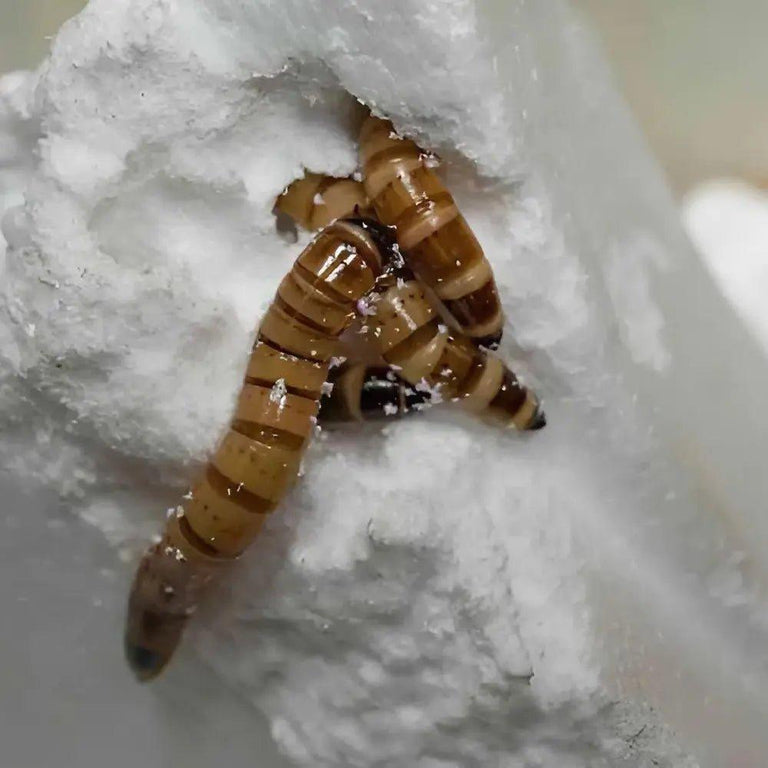Can polystyrene be recycled? Very few locations offer it. Now science shows certain worms can turn polystyrene into harmless byproducts. Polystyrene foam takes hundreds of years to break down in landfills, making these discoveries even more significant.
Polystyrene is a versatile plastic used in various products, including toys, electronics, and bean bag filling, as well as packaging for fragile items and plastic packaging for food and consumer goods. It is also commonly used for packaging fruit and vegetables, such as foam boxes or crates. But can polystyrene be recycled, and what role do superworms play in breaking it down? Let’s explore. Polystyrene foam is also known as Expanded Polystyrene (EPS).
Superworms: Nature's Polystyrene Recyclers?
While plastic is often considered non-biodegradable, new research suggests otherwise. Certain scavenger larvae, like superworms, can break down polystyrene into harmless byproducts, offering a potential solution to plastic pollution. Scientists have found that Zophobas atratus larvae can consume styrofoam as their sole diet, with gut bacteria converting it into minerals, energy, and carbon dioxide. This builds on previous findings that mealworms can also digest plastic. Expanded polystyrene (EPS) is not biodegradable, which makes these findings particularly promising.
Good News for Polystyrene Manufacturers
The discovery that superworms can eat polystyrene is encouraging for manufacturers. Businesses and manufacturers that utilise polystyrene in their operations can benefit from enhanced recycling solutions and responsible waste management practices. Polystyrene is a widely used plastic and a significant source of pollution. These worms harbour bacteria that can break down this material, offering hope for both the ecosystem and manufacturers. Businesses generating large quantities of polystyrene waste should consider tailored recycling programs to reduce their environmental impact and promote sustainability in commercial settings. Zophobas atratus can digest polystyrene due to its evolutionary history, having developed the ability to break down tough wood components. Polystyrene foam can easily be blown away and enter the natural environment, exacerbating pollution issues.
How Superworms Break Down Polystyrene
In 2015, researchers found that mealworm beetles (Tenebrio Molitor) could degrade Styrofoam using gut bacteria containing plastic-degrading enzymes. However, their small size limited their feeding rate. Scientists then investigated whether larger superworms (Zophobas atratus) with similar gut bacteria could be more effective.
The Superworm Experiment
Researchers divided superworms into two groups: one fed styrofoam and the other a natural diet. Over 28 days, the styrofoam group converted 36.7% of the polystyrene into carbon dioxide. Analysis revealed that gut bacteria broke down long polystyrene chains into smaller products. When the worms were given antibiotics to kill their gut flora, they could no longer derive energy from eating plastic.
The Future: Harvesting Bacteria for Polystyrene Recycling
The plan is to harvest these bacteria and use them to recycle polystyrene in special facilities or insert them into other insects for broader cleanup efforts. Researchers also aim to isolate bacterial enzymes for industrial-scale plastic degradation. This could lead to a biotech solution for plastic waste problems.
Impact on Superworm Health
Interestingly, superworms that eat polystyrene remain as healthy as those on a natural diet. Previous research has found that mealworms can process flame-retardant-laden Styrofoam without harm, and shrimp fed these mealworms also thrive. This suggests that bacteria may be evolving the ability to digest plastics, offering a natural solution to plastic pollution.
Can Polystyrene Be Recycled? The Challenges
Polystyrene can be recycled, but it faces challenges. Only certain types of expanded polystyrene (EPS) are recyclable; therefore, it is essential to check the type before recycling. To recycle EPS, the material must be clean and free from contaminants such as sticky tape, labels, and food residue. Meat trays and coloured polystyrene are generally not recyclable and should be disposed of properly.
Curbside collection is rare due to the cost and logistical difficulties of building Styrofoam-recycling machinery. To organise effective recycling, collect clean EPS waste at home, work, or school before taking it to a recycling site. Find a recycling site in your area that accepts EPS and check their guidelines to determine what types of EPS are accepted before dropping off the material. Polystyrene recycling involves granulation, compacting, and densifying.
Polystyrene Recycling Processes: Granulation, Compacting, and Densification
Recycling polystyrene requires a three-step process:
-
Granulation: Polystyrene waste is broken down into tiny beads using a granulator.
-
Compacting: The granules are compressed into dense bales.
-
Densification: Expanded polystyrene is shredded and exposed to high heat and pressure, forming a solid block that is then shredded into pellets. The processed polystyrene is then transformed into new products, including outdoor furniture, decking, picture frames, and skirting boards.
Uses of Recycled Polystyrene
Recycled polystyrene pellets are used for storage, transport, packaging, appliances, refrigerator trays, toys, foam, and cups. They are also incorporated into plastic furniture and building materials, such as fence panels and roof tiles.
Logistical and Economic Challenges of Polystyrene Recycling
Polystyrene recycling is difficult due to logistical and economic reasons. Its bulky nature makes collection and transport challenging, especially when dealing with large quantities of polystyrene waste, and the machinery required is expensive. Polystyrene must also be free from flame retardants before processing, adding to the cost. If polystyrene is not properly sorted, it can contaminate other recyclable materials, thereby reducing the efficiency of the recycling process. Polystyrene foam occupies a significant amount of space in landfills, further complicating waste management efforts.
The Benefits of Polystyrene Recycling
Despite the challenges, polystyrene recycling is a beneficial process. Polystyrene production has relatively low carbon emissions compared to other plastics. Widespread recycling could significantly reduce environmental impact, as recycling polystyrene helps prevent pollution and reduces the amount of waste sent to landfills.
Superworms and the Future of Polystyrene Waste
The discovery that superworms can break down polystyrene is promising, given the challenges associated with recycling it. In 2018, the world produced 359 million tonnes of polystyrene, but only 33 million tonnes were recycled. Superworms and other plastic-eating organisms offer a potential solution, turning plastics into harmless byproducts. However, polystyrene foam should never be placed in your home recycling bin.
The Future of Plastic Waste Management
In the future, plastic-digesting bacteria could be introduced into more species or utilised in industrial processing, thereby eliminating the need for traditional recycling. This could make plastic as “natural” as any other food source in the environment. For bean bag producers, these developments are encouraging, ensuring the continued use of state-of-the-art plastic-based fillings with natural methods to break them down.
For readers in Australia, particularly those in Victoria (VIC), practical recycling solutions are available for polystyrene. Local drop-off sites enable you to dispose of polystyrene waste responsibly. Most sites operate Monday to Friday, excluding public holidays and weekends, so please check operational hours before taking your materials for recycling. For more information about collection and drop-off services, contact or email your local recycling provider. Click on the provided links or maps to find a recycling site near you.





